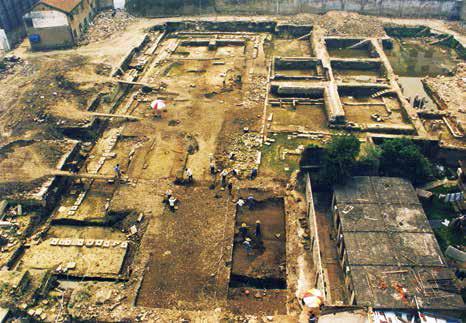An Archaeologist’s Review of Cities in Zhejiang
2019-03-18ZhengJiali
Zheng Jiali

寧波元代永丰库遗址发掘场景。 郑嘉励 提供A birds-eye view of the ruins of Yongfeng Warehouse built in the Yuan Dynasty; the ruins in Ningbo were first unearthed in 2001.
Cities of Zhejiang
What is now known as Zhejiang was primarily Yue Kingdom in the Spring and Autumn (770-746BC) period of China, with present-day Shaoxing as the capital. After the Qin unified the whole country and set up a national administrative system of prefectures and counties, Shaoxing was the capital of Kuaiji Prefecture which ruled over the whole of Zhejiang of today. It was in the Three Kingdoms period of China that some more prefectures appeared in Zhejiang. As dynasties followed each other, more prefectures appeared. The map of Zhejiang with all its major cities (capitals of prefectures) today looks like those in the Ming and the Qing.
Shaoxing was the most important city in Zhejiang for centuries before the Sui and the Tang dynasties. Toward the end of the Tang, Dong Chang, a warlord, occupied Shaoxing as his base and let his general Qian Liu rule in Hangzhou, which was much less important than Shaoxing back then. Qian set up Wuyue Kingdom and housed the royal family in Hangzhou. Under the 72-year rule of the Qian family, Hangzhou prospered. When the royal house of the Song fled to Hangzhou after it lost its vast land in the north to the nomads, Hangzhou became the national center of politics, economy and culture. After losing its dominance to Hangzhou, Shaoxing declined further as Ningbo, called Mingzhou back then, prospered as a harbor city engaged in international trade with Japan and Korea. In modern days, Wenzhou in the south became another important city in Zhejiang. Shaoxing was pushed back to the fourth. The provinces vehicle registration plate system categorizes Hangzhou as A, Ningbo as B, Wenzhou as C, and Shaoxing as D, reflecting the ranking of the cities in the province.
In a sense, a history of cities in Zhejiang over the last 2,000 years tells the story of how Shaoxing got marginalized after it 1,000-year dominance and how Hangzhou rose to top.
Cities in Detail
Historical documents would be enough if all one needs is a general review of how cities evolved in the province over the past 2,000 years. But knowledge from historical texts is no longer sufficient if one wants details of how a city evolved and went through prosperity and tribulations and when it changed its jurisdictions in national and provincial government systems. Archaeological finds provide concrete evidences.
Historians know relatively a lot about Hangzhou and Ningbo from the 10th century on as historical literature have reliable texts and maps to provide a general idea, but little is known about cities in Zhejiang in the Sui Dynasty and the Tang. For example, they dont know whether the capital of Dongyang Prefecture in the Six Dynasties period had a city wall. Nor do they have the slightest idea of whether the workshops in the capital of Yuezhou Prefecture in the Tang Dynasty had separating walls.

市民從镇海千年龙窑遗址前经过。 胡宇飞 摄A local resident walks past the ruin heap of a dragon kiln which operated for about ten centuries in Zhenhai, part of Ningbo in eastern Zhejiang.

富阳瓦窑里考古发掘工作场景。(浙江省文物考古研究所提供)Two archaeologists work at an excavation site at Wayaoli, Fuyang, which is now a district of Hangzhou.
Archaeologists have difficulties to find out the details of these cities as most cities in Zhejiang are built on the same place. Experts have little to explore as crowded cities dont offer them precious opportunities to look down into the past cities buried deep underground in present-day cities. For example, the past cities of the 3rd century to 7th century are buried about 4 to 5 meters deep down in the ground. The capital city of Hangzhou of the 10th to 13th century is buried about 2 to 3 meters deep down underground in present-day Hangzhou. With a large population and highly concentrated urbanization, Zhejiang gives little chance for archaeologists to explore the buried past of the big cities.
The Inner City of Jiaxing, explored in 2015, revealed the ancient site in two ways. Archaeologists first determined where the city wall used to stand. Then they traced the central axle and finally they got the whole map of the inner city. Next, they dug a trench near the northern section of the city wall. The 5-meter-deep trench revealed layers of different dynasties stacked one upon another. In 2018, a similar excavation project was conducted at the Panchi Site at Confucius Temple in Jinhua in central Zhejiang. Now, the temple is being reconstructed and the pond Panchi will be restored too. These two are examples of archaeological layers in one place.
But there is an exception. For a long time, archaeologists believed that the capital city of Linhai Prefecture (present-day Taizhou) was buried deep underground beneath the present-day Zhangan town. A few years ago the town was constructing a drainage system when people stumbled upon the remains of the old city in a large area of rice paddies. Archaeologists found a lot of bricks, pottery, and other construction materials that can be traced back to the Han dynasty up to the Six Dynasties. Based on the evidence, archaeologists have determined the size of the old capital city, which, in fact, was abandoned after the county was removed from the administrative system.
Though archaeologists dont have much chance to dig down in big cities across Zhejiang, they have formulated a complete plan for what to do in case an opportunity pops up in future. Take the city of Linan (present-day Hangzhou) of the Southern Song Dynasty for example. It took archaeologists a few years to draw a map of the Royal Ancestral Temple and some temples near it. It would probably take several generations of archaeologists to complete a whole map of the national capital about 900 years ago. Archaeologists view the restoration of the past Hangzhou in three ways. At the macro level, the city changed in size in the Tang, the Song and the Yuan. At the middle level, archaeologists look at roads, lanes, shops, residential communities, workshops, etc. At the micro level, archaeologists concentrate on palaces in the Forbidden City. Details uncovered in excavation projects on the royal compound could reveal technology, architecture, workmanship used in the construction of the palaces. If differences exist, these differences could tell stories about the royal compound itself.
